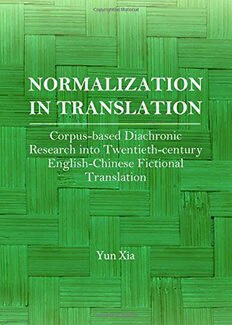
Normalization in Translation: Corpus-based Diachronic Research into Twentieth-century English Chinese Fictional Translation PDF
Preview Normalization in Translation: Corpus-based Diachronic Research into Twentieth-century English Chinese Fictional Translation
Normalization in Translation Normalization in Translation: Corpus-based Diachronic Research into Twentieth-century English–Chinese Fictional Translation By Yun Xia Normalization in Translation: Corpus-based Diachronic Research into Twentieth-century English–Chinese Fictional Translation, by Yun Xia This book first published 2014 Cambridge Scholars Publishing 12 Back Chapman Street, Newcastle upon Tyne, NE6 2XX, UK British Library Cataloguing in Publication Data A catalogue record for this book is available from the British Library Copyright © 2014 by Yun Xia All rights for this book reserved. No part of this book may be reproduced, stored in a retrieval system, or transmitted, in any form or by any means, electronic, mechanical, photocopying, recording or otherwise, without the prior permission of the copyright owner. ISBN (10): 1-4438-6037-9, ISBN (13): 978-1-4438-6037-6 TABLE OF CONTENTS List of Tables ............................................................................................. vii List of Figures........................................................................................... viii Acknowledgements .................................................................................... ix List of Abbreviations ................................................................................... x Chapter One ................................................................................................. 1 Introduction Chapter Two .............................................................................................. 12 Corpus Methodology in Translation Studies Chapter Three ............................................................................................ 36 Creating and Using the Diachronic Corpus Chapter Four .............................................................................................. 54 Lexical Normalization Chapter Five .............................................................................................. 75 Normalization of Collocation Chapter Six ................................................................................................ 96 Syntactic Normalization Chapter Seven .......................................................................................... 126 Contextualization of Textual Norms Chapter Eight ........................................................................................... 144 Conclusions Appendix A ............................................................................................. 151 Appendix B .............................................................................................. 154 vi Table of Contents Appendix C .............................................................................................. 155 Appendix D ............................................................................................. 157 Notes ........................................................................................................ 159 Bibliography ............................................................................................ 162 Index ........................................................................................................ 179 LIST OF TABLES Table 3-1. General features of the two translated subcorpora Table 3-2. Overall size of each subcorpus Table 4-1. POS distribution in the four Chinese subcorpora Table 4-2. Distribution of nouns in TCT1 and OCT1 Table 4-3. Distribution of nouns in TCT2 and OCT2 Table 4-4. Frequency difference of pronouns in translated vs. original texts Table 4-5. Frequency data of personal pronouns Table 4-6. Overlapping rate of high-frequency words Table 4-7. Compositionality of five quasi-affixes Table 5-1. Frequency of selected nodes Table 5-2. Collocates of selected nodes Table 5-3. Lexical collocates of the node (cid:23429) in TCT2 Table 5-4. Frequency percentages of the top collocates of each node in TCT1 and OCT1 Table 5-5. Frequency percentages of the top collocates of each node in TCT2 and OCT2 Table 5-6. Repetition rate of the a ((cid:9431)/(cid:5583)) n collocation Table 5-7. Frequency of major translation methods Table 6-1. Overall frequency data of connectives Table 6-2. Categories of TDCs in TCT1 and TCT2 Table 6-3. Overlapping rate of connectives in translated vs. non-translated texts Table 6-4. Frequency data of prepositions Table 6-5. Top 6 prepositions in each subcorpus Table 6-6. Bilingual concordance results of (cid:3981)(cid:6877) Table 6-7. Frequency data of Chinese passive markers Table 6-8. Long and short passives in different subcorpora Table 6-9. Long and short agents in long passives Table 6-10. Mean sentence length and sentence segment length Table 6-11. Number of long SS (15-20 words in length) Table 6-12. Distribution of major types of headword LIST OF FIGURES Figure 2-1 Flowchart of a corpus-assisted translation study Figure 3-1. Composition of DPCECF Figure 3-2. Model for a diachronic study of normalization Figure 3-3. Flow chart of corpus construction Figure 4-1.A broken line graph of POS distribution Figure 4-2. Frequency of common nouns and proper nouns in source texts and translations Figure 4-3. Distribution of different types of pronouns in each subcorpus Figure 4-4. Frequency proportion of high-frequency words Figure 4-5. Proportion of mono- and poly- syllabic words Figure 4-6. Proportion of monosyllabic words in translated texts Figure 4-7. Normalized frequencies of 5 affixes in TCT1 and OCT1 Figure 4-8. Normalized frequencies of 5 affixes in TCT2 and OCT2 Figure 6-1. Frequency of connectives in each translated text pair Figure 6-2.Frequency percentage of long passives with bei and gei Figure 6-3.Distribution of agent length in long passives Figure 6-4.Semantic features of syntactic passive constructions ACKNOWLEDGEMENTS My special thanks first go to the Humanities and Social Sciences Foundation of the Ministry of Education of China for supporting my research project “A Corpus-based diachronic Study of Normalization in English–Chinese Translated Fiction” (grant reference 10YJC740108). I am also grateful to grants from China National Foundation of Social Sciences (grant reference 10BYY008), National Grants for Social Sciences Major Projects (grant reference 10ZD&127), the China Scholarship Council (CSC) and the Doctoral Research Fund of Qufu Normal University for being able to work intensively on a research project of my choice. The research conducted for this book would not have been possible without the professional guidance from Professor Defeng Li, my Ph.D. supervisor, from the School of Oriental and African Studies, University of London. I am also grateful to Professor Hongwu Qin for his precious advice on my corpus construction and the use of corpus tools for corpus analysis. I should also thank Doctor Richard Xiao in Edge Hill University, U. K. for kindly sharing the invaluable corpus resource, LCMC, which is of great value to this study. —Yun Xia April 2014
